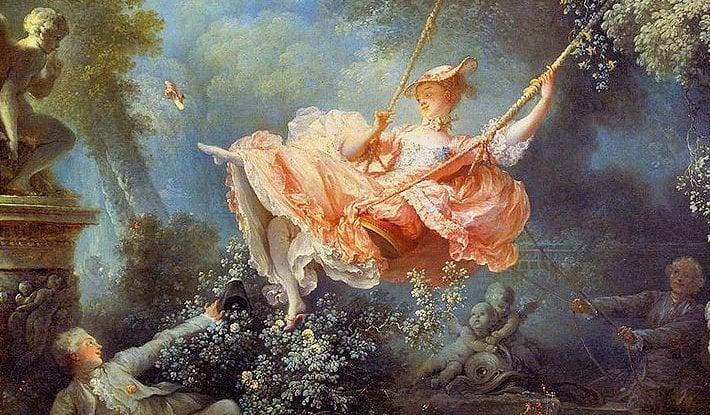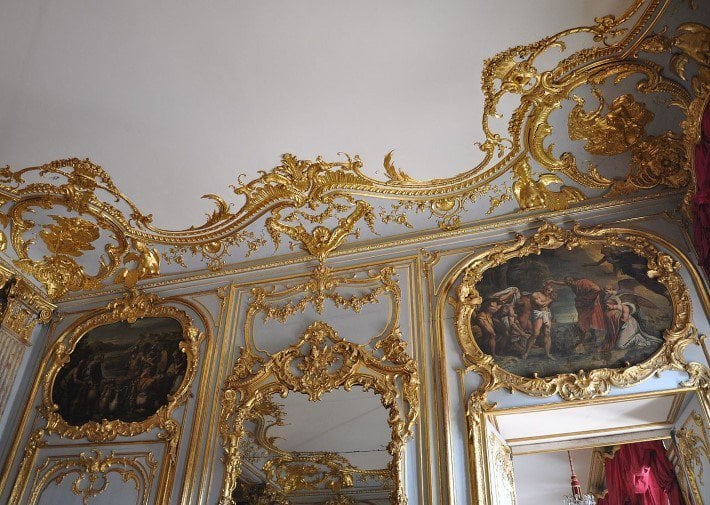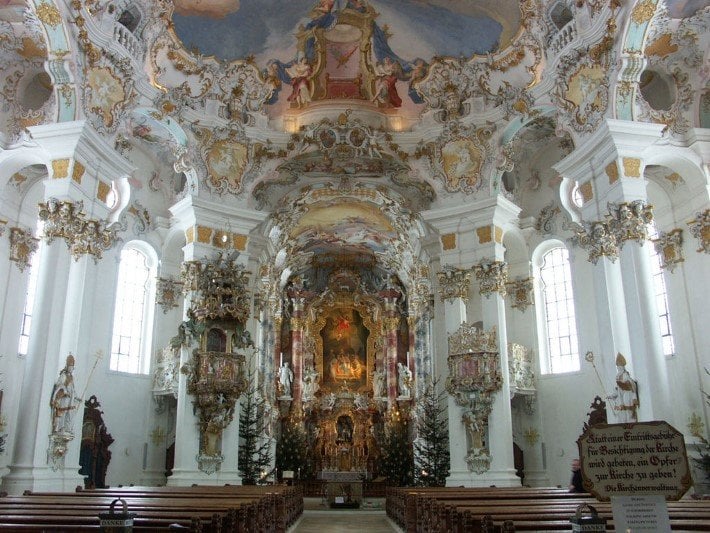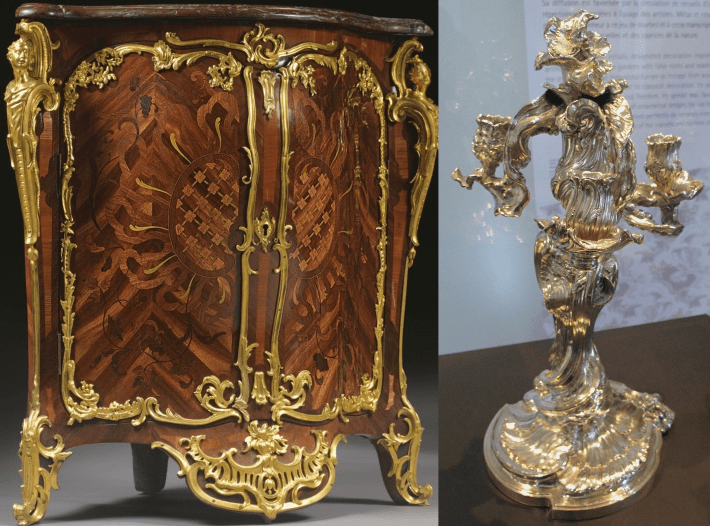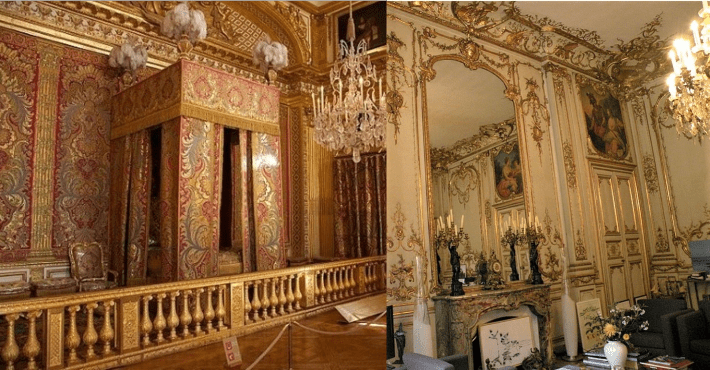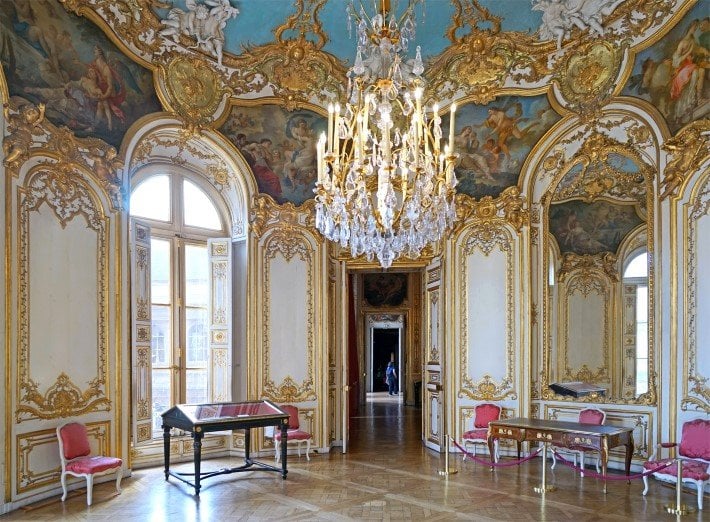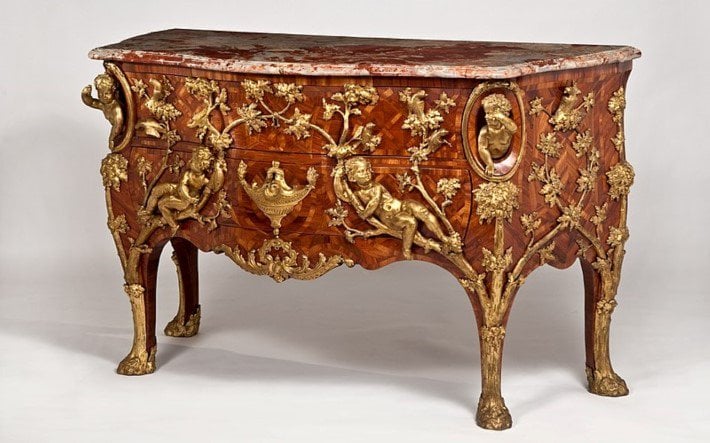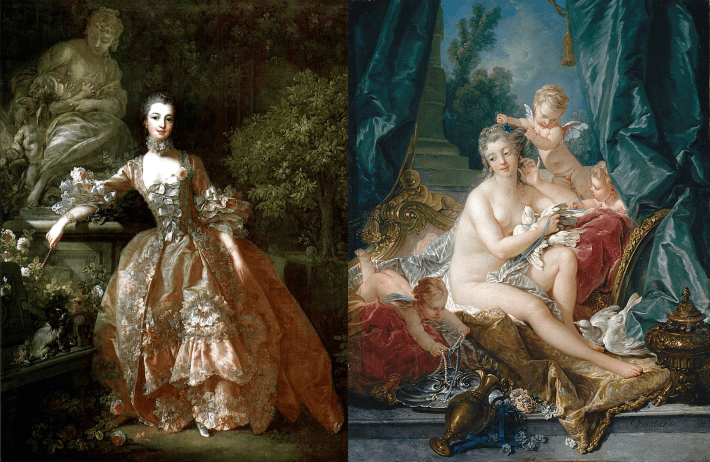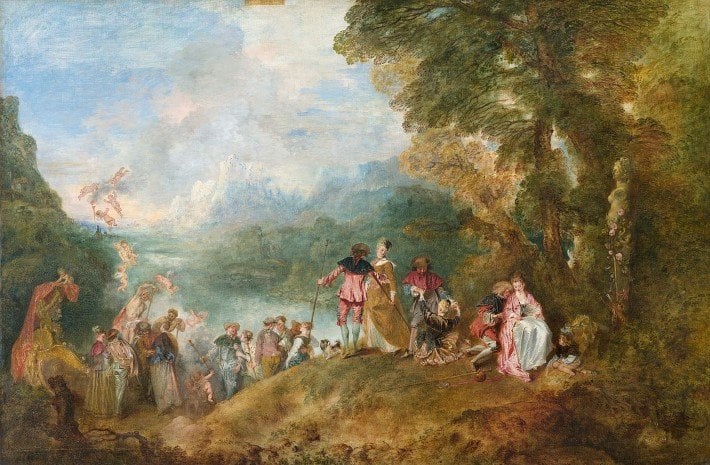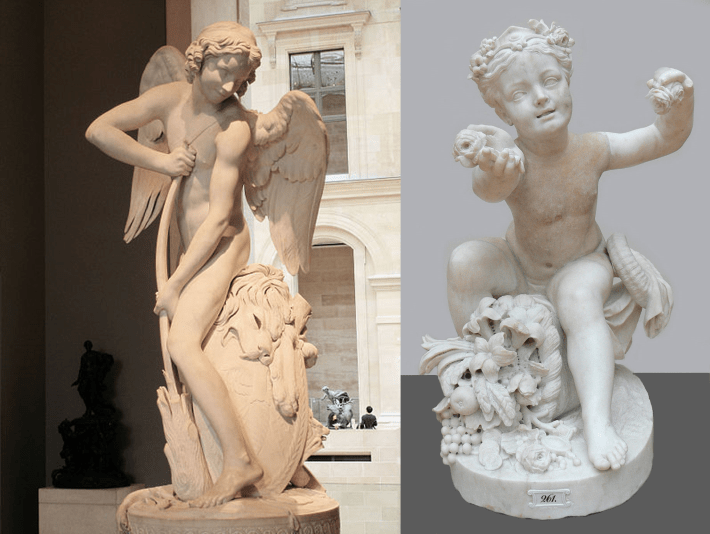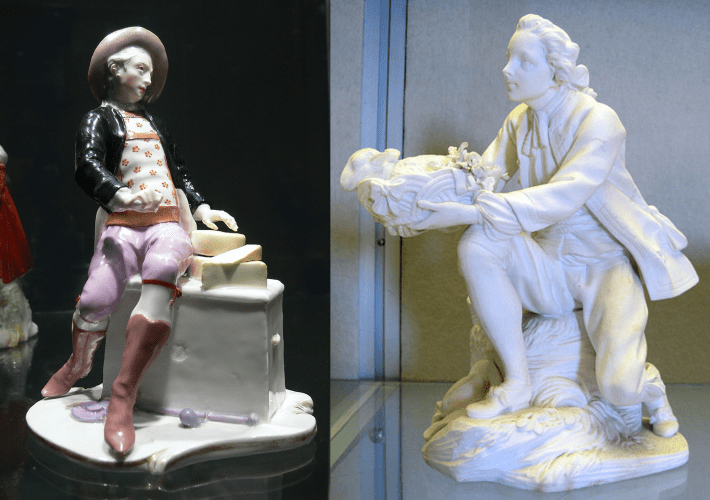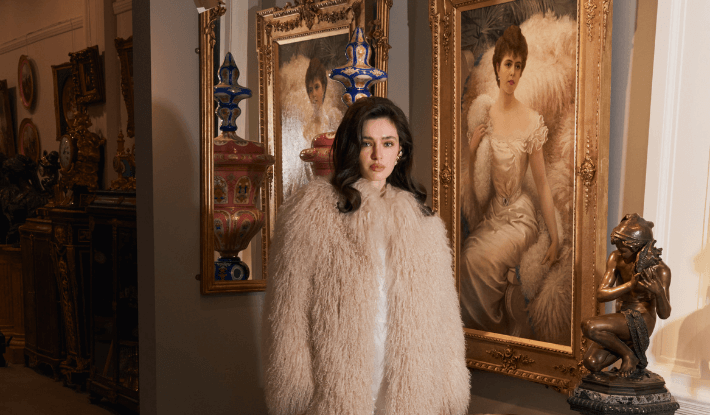What was the Rococo?
Sensuous curves, gilded femininity and an unparalleled glittering elegance are crowing features of the Rococo, which was a decorative style that dominated interior design, furniture, painting and sculpture during the 18th Century.
The Rococo loosely coincided with the reign of King Louis XV, who ruled France from 1715 until 1774, and its popularity has often been attributed to the patronage of Madame de Pompadour, the king's mistress who took on a formal role as an advisor within his court between 1745-1751.
The style was exuberant and striking, yet contrastingly intimate and ‘cosy’. It championed a taste for superior craftsmanship and fine, luxurious materials which resulted in a decadent, unified ensemble for decorations.
The Rococo is sometimes referred to as the 'late Baroque', since it is a style that evolved from the Baroque style and represents the final hurrah of this period in art history. By the end of Louis XV's reign, the Rococo was replaced by Neoclassicism, a new style altogther which reacted against the flamboyance of the Rococo. (You can read more about the Baroque and Neoclassical styles in our other blog posts.)
What does 'Rococo' mean and where does the name come from?
Whilst the Rococo spanned much of the 18th Century, the word Rococo, wasn't used until later in the 19th Century.
The name Rococo emerged from the French word Rocaille, a term that was used during the 18th century in France to describe the emerging style (Style Rocaille).
The term Rocaille, meaning ‘rock work', refers to the scrolling seashell and rock motifs that became popular following the trend for man-made grottoes in the pleasure gardens of wealthy estates in the late 17th and early 18th Century.
These motifs, portrayed with a sense of a free-flowing exuberance, were widely adopted by the new style and often form part of the designs which define artworks as typically Rococo, as shown in the example below.
Rococo style decorations at the Rohan Palace, Strasbourg. © Philip Ales via Wikimedia Commons. Note the typically Rococo shell-form rocaille motifs, incorporated in the carved gilded details.
The Rococo, occasionally spelled Roccoco, can also be referred to as Late Baroque. The name Rococo may have been coined as an amalgamation of the terms Rocaille and Baroque.
Where and why did the Rococo begin?
Unlike many stylistic movements in the history of art and design, the Rococo was more of an evolution of past styles than a conscious revolution or an all-new invention. Quite simply, it emerged as a lighter, more graceful version of the existing Baroque style.
The Rococo originated in France, where there was a very strong link between the king at the time and the dominant artistic style.
King Louis XIV, who reigned France from 1638-1715, was well-known for his love of the Baroque style, and the French Baroque is commonly referred to as the Louis XIV style.
Following the death of Louis XIV, his great-grandson Louis XV came to the throne at only five years of age.
King Louis XV’s uncle ruled in his place until he reached maturity in 1723, meaning that the power of the monarch was somewhat unusually split between the young King and his advisors.
With no absolute and all-powerful king on the throne, the formality of the French court, that had been so well established under Louis XIV, started to change, and royal proceedings became less public and more intimate.
Consequently, every element of the court became less formal, including the interior style. This was a key factor in the emergence of the Rococo.
As a mature king, Louis XV, together with his official mistress, Madame de Pompadour, redecorated and refurnished many parts of the Palace of Versailles in this new style, and hence, by Royal association, the Rococo very quickly became popular.
Like Louis XIV and the Baroque, the French Rococo became synonymous with the reign of King Louis XV, and is commonly referred to as the Louis XV style or Louis Quinze style.
Where did the Rococo hold influence?
The Rococo style emerged in Paris and spread rapily throughout France. By the 1730’s the style had widened to neighbouring Catholic countries Germany and Austria, where it achieved a new level of extravagance and became a particularly fashionable style for the decoration of churches.
The Wieskirche in Bavaria, Germany (shown below), is one of the most famous examples of the German Rococo style, featuring white walls with fanciful carvings, and pastel-coloured decorations.
Wieskirche in Bavaria, Germany designed in the late 1740’s by J. B. and Dominikus Zimmerman in the German Rococo style. © Mattana via Wikimedia Commons.
South of France, the Rococo spread to Italy, with Venice, Rome and Milan becoming important centres for the new style in the fields of furniture and the decorative arts.
In Spain and Portugal, the Rococo adapted to local customs and became known as Spanish Colonial style. As this new hybrid style, the Rococo crossed the Atlantic to North and South America.
Finally, through trade and consequent cultural exchange, the Rococo was introduced to China and the East. Conversely, many traditional Eastern decorative motifs and techniques were adopted by the Rococo in Europe, a feature known as 'chinoiserie'.
What does the Rococo style look like?
The Rococo style is characterised by intense decorations, curvaceous shapes and a complicated, detailed appearance.
Typically, it is a style full of ornamental elements such as stylised acanthus leaves, short curves, C-shaped and S-shaped srolls, finely rendered 'shredded' details, sea-shells, flowers and elements of mythology and fantasy.
The Rococo is also distinctive for its lack of symmetry. Many of the motifs and designs forming the Rococo style were designed so as to appear free-flowing and organic, sprawling languidly and exuberantly.
Typical features are pastel colours, gold and white, marquetry and parquetry in wooden furniture and ornately carved elements.
Elements that were influenced by trade with the East, chinoiserie, were also included in the Rococo style. It was not unusual for the Rococo to include Japanese lacquerwork or Chinese figures and landscapes.
Left: cabinet with marquetry, c. 1750, by Jean-Pierre Latz (German, worked in Paris, 1691-1754) © Promking via Wikimedia Commons and right: candelabra, c. 1735-40, by Meissonnier (French, 1695-1750) © Sailko via Wikimedia commons
How did the Rococo differ from the Baroque?
The Rococo was a style the emerged and evolved from the Baroque and, like the Baroque, it produced an elaborate spectacle to the draw the eye in from all directions.
However, where the preceding dominant Baroque style under Louis XIV had been powerful, colossal and grand, the Rococo was less formal and decorated a more intimate kind of interior.
In terms of the overall effect, the Baroque in France was deliberate, heavy-handed and monumentally provocative, embracing ceremony and royal formalities. The Rococo, by contrast, was light and playful in its elaborate decoration, embracing comfort, warmth and privacy.
The Baroque extended to encompass all aspects of arts and design, from architecture to sculpture and painting, whereas the Rococo never fully took hold in architecture.
Where the Baroque favoured dramatic, bold, contrasting colours, the Rococo championed more gentle, delicate shades of gold, white and pastel palettes.
Furthermore, the Baroque was a religiously motivated movement, and, by contrast, the Rococo was unfettered by politics or religion.
Finally, whilst the Baroque was conceived by the Catholic church with clear religious motivations, there was no specific meaning behind Rococo style decorations, paintings, or sculpture, except for their beauty, intricacy and elegance. For this reason, toward the late 18th Century, the Rococo and the artists that promoted it, came under fire for being fripperous and lacking substance.
Left: the State Bedchamber of Louis XIV in the Baroque style, Versailles, © Jorge Lascar via Flickr and right: the Cabinet du Ministre in the Rococo style at the Hotel de Roquelaure, Paris © Chatsam via Wikimedia Commons. Note the rich colours of the Baroque versus the lighter whites and gold of the Rococo!
What was the Rococo influence on interior design?
Rococo interiors were most often decorated as a whole – paintings, furniture, walls, ceilings, metalwork and porcelain would present a unified ensemble.
It was common for rooms decorated in the Rococo style to be decorated all over with ‘boiserie’ – wooden panelling with decorative carvings.
The boiserie would often include the core elements of the Rococo style – shells, C-shaped and S-shaped scrolls, stylized acanthus leaves and flowers.
Most commonly the boiserie would be painted thematically, with gilded elements on a white background, or several shades of complementing pastel colours.
One of the most famous examples of the Rococo interior that survives today was created in the Salon de la Princesse at the Hotel de Soubise in Paris.
Salon de la Princesse at the Hotel de Soubise, Paris by Germain Boffrand, Charles-Joseph Natoire and Carle Van Loo, 1735-40. © Jean-Pierre Dalbera via Flickr.
The Salon de la Princesse is decorated with ornate boiserie that is emblematic of the Rococo style in white and gold.
Rather than being hung, the paintings are incorporated as a cycle into the curved walls and ceiling, which is painted a fanciful sky blue.
The curved shape of the room creates a more intimate, hallowed space rather than an echoing hall, and the light – which would have been created by candles – would glimmer from every element of the gilded details, creating a warm and cosy elegance.
What was the Rococo influence on furniture and the decorative arts?
Rococo in furniture and the decorative arts was all about artistic panache and sumptuousness.
Workmanship of the highest quality was of the utmost importance in creating furniture and objects. It was common for several kinds of workmen to work together on just one single piece!
This commode is an excellent example of the very best of Rococo furniture making and design.
Rococo style commode or chest of drawers by Charles Cressent, c. 1730. The commode is crafted in oak, pine, satinee and purpleheart woods, gilt bronze and marble. © MarvellousElephant via Wikimedia Commons.
The commode features curved, tapered legs, which are called ‘cabriole’ legs. These kinds of legs can be found in lots of pieces of Rococo style furniture, and as time went on they became taller, more slender and daintier in contrast to the large, bulbous shape they support.
The commode is highly decorated, and would have been worked on by several craftsmen – a draughtsman to design the piece, a carpenter who would have made the design and the parquetry, and a bronzeworker who would have created the ormolu mounts.
Another feature of the Rococo that became popular was asymmetrical elements in furniture and design. Pieces aimed for a harmonious ‘balance’ that is more often found in nature rather than rigorous, symmetrical perfection.
In this commode, the gilt bronze mounts are crafted with a ‘freehand’ effect, meaning that while they aim to be roughly symmetrical, subtle differences by the hand of the maker form part of the charm and elegance of the piece, highlighting the carefree informality that was so inherent to the style.
What was the Rococo influence on painting?
Rococo painting was characterised by an abundance of intricate details, curves and counter-curves which dance across the canvas, resulting in a very ‘busy’ appearance.
Within this fanciful, ‘busy’ style, portraits, pastoral scenes and mythological subjects with themes of love would often form the bulk of works produced.
One of the most notable painters in the Rococo style was Francois Boucher (French, 1703-1770), who enjoyed the patronage of King Louis XV and his mistress, Madame de Pompadour. Madame de Pompadour was a great patron of the arts, and one of the most famous fans of the Rococo movement.
Boucher painted Madame de Pompadour several times throughout the period, as well as the light-hearted, mythological subjects which characterised the Rococo.
Left: Madame de Pompadour, 1759 and right: La Toilette de Venus, 1751, both by Francois Boucher.
Whilst it was regarded as unflattering for any Royal portraits to include nudity, it is easy to see a distinctive style in both of these paintings by Boucher. They are both painted with pastels and shades of pink against mystical green and blue backgrounds.
The portrait of Madame de Pompadour is full of flowers and intricate, delicate foliage. La Toilette de Venus includes winged cherubs, a similar garden setting in the background, and many intricate and delicate items at the feet of the nude Venus.
Both paintings are fanciful and feminine, celebrating a traditional womanly persona that was very fashionable in the 18th Century and characterised the Rococo style.
Another distinctive style within Rococo painting was the ‘fete galante’ – a French term that loosely means ‘courtship party’. This phrase came into use to describe the paintings of Antoine Watteau (French, 1684-1721).
The Embarkation for Cythera, 1717, by Antoine Watteau
Fete galante paintings are characterised by an outdoors composition, usually a gathering or a picnic, with upper class ladies and gentlemen engaging in flirtations and conversations.
Here, the Embarkation for Cythera depicts a pretty, pastel-shaded landscape with flying cherubs to the centre left, adding a mythological element that is a common theme in most Rococo paintings.
What was the Rococo influence on sculpture?
The Classically influenced style of sculpture that was popular during the preceding Baroque continued to be created during the Rococo movement. However, alongside this, lighter subjects became popular, and more whimsical pieces were created.
Once again, Madame de Pompadour was one of the greatest patrons of Rococo style sculpture, and she commissioned many pieces for the orangery of the Chateau de Choisy where she would retire with her lover, King Louis XV of France.
To befit this romantic location, equally romantic sculptures were most fitting.
Left: Cupid Carving Darts of Love from the Club of Hercules, 1750, © Neuceu via Wikimedia Commons and right: Genius of Abundance, 1731 © Andreas Praefcke via Wikimedia Commons, both by Edme Bouchardon.
Edme Bouchardon (French, 1698-1762) created the sculpture of Cupid Carving Darts of Love from the Club of Hercules for the orangery garden, which is influenced by the Baroque and Classical sculpture, yet has a delicate, romantic theme of love triumphing over all strength.
Bouchardon sculpted many light-hearted sculptures, such as the Genius of Abundance, a small, delicate child who gracefully proffers fruits, representing the beauty of abundance.
As well as delicate themes of the works of Bouchardon, perhaps, rather unusually, one of the other greatest creations of the Rococo sculptural style actually came from the manufactory of porcelain at Sevres.
The Sevres Porcelain Manufactory was bought by Madame de Pompadour in 1756, and from then it enjoyed Royal patronage, which, along with the fine works it created, was instrumental to its success.
The sculptor Etienne-Maurice Falconet (French, 1716-1791) became creative director at the Sevres factory in 1759, and he was influenced heavily by small, delicate porcelain figures which were made in Bavaria.
He began to create larger-scale works in this style as a sculptor, and soon the Sevres Manufactory began to produce small-scale porcelain works influenced by the Bavarian models which were adapted into the French Rococo style.
Left: Bavarian figure of a cheese-seller by Bustelli, 1755, Nymphenburg Porcelain Manufactory, © FA2010 via Wikimedia Commons and right: a white porcelain figure of a man, 1769, Sevres Manufactory © Sailko via Wikimedia Commons.
Whilst the Bavarian Nymphenburg Porcelain Manufactory made figures in glazed and painted porcelain, the French Rococo pieces made by the Sevres Manufactory were of white, bisque porcelain, and looked more like real sculptures.
They were delicately small and charming and were very popular in the 18th Century as table-top decorations.
What is the Rococo influence today?
The legacy of the Rococo still reverberates today.
It has become a common practice for modern and contemporary interiors to include a contrasting piece in the Rococo style, where the intricate details and fine craftsmanship are highlighted against a more minimal setting.
The Rococo today influences fashion designs, art, interiors and the cinema with its elegance and rich history.
It has become one of the most well-loved styles in the history of art and design for its glamour and refined sumptuousness, and it is celebrated by the many historic buildings across Europe where we can find rooms still decorated in the style.
Everywhere it can be found, the Rococo is an homage to the 18th Century, the Golden Age of French design and the fine arts.




